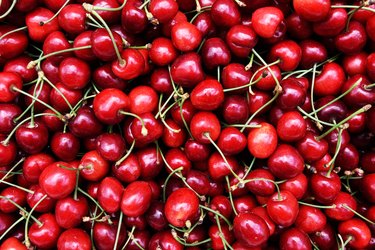
Pies, fruity cocktails and banana splits are all better with a cherry on top. Especially during the summertime when cherries are in season, you can add the fruit to any meal for some extra sweetness, and for some added health benefits.
If you come across a cherry tree while on a summer hike, it can be tempting to pick and snack on a few fruits, but you may want to think twice before you pick a few from the tree. Although the most common wild cherries are safe to eat, it can be easy to confuse fruits in the forest.
Video of the Day
Video of the Day
Related Reading
Are Wild Cherries Edible?
Two common wild cherry trees in North America are the Black Cherry and Chokecherry, according to Eat the Planet. These types of wild cherries are edible.
- Black cherries: These are also known as mountain black cherries and are dark in color. You'll find them surrounded by leafy twigs of white flowers with five petals each.
- Chokecherries: Chokecherry trees are brown-black with berries that are lighter red in color. Like black cherries, chokecherries are surrounded by fragrant white flowers and leaves.
Generally, cherries are a safe fruit to eat. They contain plenty of healthy antioxidants, but eating too many cherries can cause gas and bloating.
Ultimately, you'll want to avoid the fruit pits, bark, leaves and stem — these parts of the plant can be toxic.
Cherry pits contain cyanide, a type of toxin, but the poisonous part of the pit is actually encapsulated by the pit itself — so, generally, accidentally swallowing a pit won't cause any harm, according to the National Capital Poison Center. Just don't chew on or eat a crushed cherry pit.
Also, make sure kids spit out the pits of fruit or take out the pits before serving to small children to prevent accidental consumption.
Warning
If you swallow a few pits and are concerned, or begin to feel symptoms of weakness, headache, confusion or nausea, go to a doctor or call emergency services immediately.
Why Eating Wild Fruit Is Risky
Although wild cherries are usually safe to eat, it can be easy to confuse them with other wild fruits or berries, such as the poisonous deadly nightshades or moonseed berries, per Eat the Planet.
Unless you're 100 percent sure the fruit you found is safe to eat, it's probably best to avoid eating any wild plants at all.
If you're on a hike with small children, keep an eye on any plants or berries they may see along the way. American Bittersweet berries, Cotoneaster berries and Holly berries look extremely similar to berries you may buy at the grocery store but can be dangerous if you eat them, according to the Children's Hospital of Philadelphia.
Keep in mind that cherries are usually ripe between May and June, depending on the species. So, if you're outside in October and come across what looks like a cherry in the forest, you definitely won't want to eat any of the fruit.
Warning
It can be easy to confuse fruit in the wild. Some foragers may mistake black cherries for poisonous plants such as deadly nightshade or moonseed berries, which look similar to black cherries or grapes.
Unless you're 100 percent sure the fruit you're eating is cherry, it's safest to leave the plant alone and buy your cherries at the store.